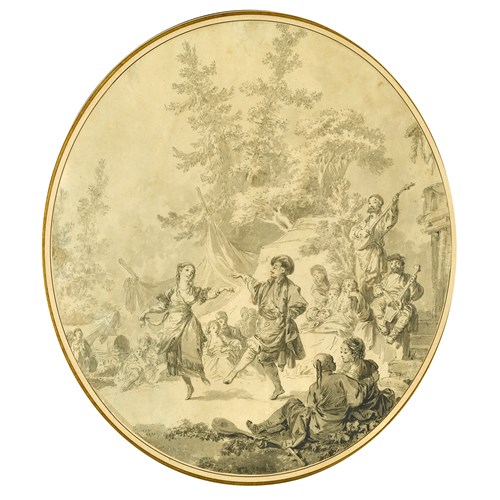Marketplace
A Torrent in a Scandinavian Landscape, a House Beyond
Salomon Rombouts
A Torrent in a Scandinavian Landscape, a House Beyond
Period 1600-1750, 17th century, 18th century
Origin Italy, The Netherlands
Medium Oil on panel
Dimension 36.5 x 32.2 cm (14³/₈ x 12⁵/₈ inches)
This dramatic composition by Salomon Rombouts depicts a river rushing through a rocky northern landscape. The moving water exerts a dynamic presence, gathering speed as it diverts around a large boulder and cascades on either side, adding tension to the otherwise tranquil surroundings. Waterfalls were popular elements in the work of seventeenth-century Dutch masters such as Jacob van Ruisdael (1628-1682) and Allaert van Everdingen (1621-1675), whose paintings clearly influenced Rombouts, and ‘can be interpreted in Baroque terms as a symbol of man’s transitory and ephemeral existence’.¹ A Torrent in a Scandinavian Landscape, a House Beyond brings to mind the power and unpredictability of natural phenomena, particularly if the movement of the water is contrasted with the mundane activities of the figures along the bank. On the left, two men attempt to shift the fallen tree trunks lying on the ground, and further along the path, a rider followed by a boy leading two horses approaches. Another man crosses the bridge in the centre of the composition and his diminutive figure looks lonely and precariously balanced above the turbulent water.
Little is known about Rombouts’ life and it has not been determined whether he visited high-mountain regions such as those depicted here. Like Ruisdael, he probably based the painting on examples by van Everdingen, who travelled to Norway and Sweden in 1644. Van Everdingen’s Forest Scene with Water-Mill, executed c.1650, has many elements in common with the present work, including the rough timbered building, craggy rocks and brooding tonality. The addition of the castle in A Torrent in a Scandinavian Landscape, a House Beyond, parallels the fortifications often depicted in Ruisdael’s landscapes, such as Waterfall with a Half-Timbered House and Castle in the Fogg Museum, Harvard, and heightens the romanticism of the scene. Rombouts’ idyllic views were further inspired by Ruisdael’s pupil, Cornelis Decker (1620-1678), which is evident in his depiction of monumental trees and brooding skies in paintings such as Entrance to the Forest in the Louvre Museum.
Rombouts was the son of the painter Gillis Rombouts (c.1630-1678), with whom he may have initially studied, before being admitted to the Haarlem guild in 1678. He is recorded as having moved to Florence by 1690.
¹ Gabriele Groschner, Thomas Habersatter, Erika Mayr-Oehring (Ed.), Masterworks, Residenzgalerie Salzburg, Salzburg 2002, p. 28.
Little is known about Rombouts’ life and it has not been determined whether he visited high-mountain regions such as those depicted here. Like Ruisdael, he probably based the painting on examples by van Everdingen, who travelled to Norway and Sweden in 1644. Van Everdingen’s Forest Scene with Water-Mill, executed c.1650, has many elements in common with the present work, including the rough timbered building, craggy rocks and brooding tonality. The addition of the castle in A Torrent in a Scandinavian Landscape, a House Beyond, parallels the fortifications often depicted in Ruisdael’s landscapes, such as Waterfall with a Half-Timbered House and Castle in the Fogg Museum, Harvard, and heightens the romanticism of the scene. Rombouts’ idyllic views were further inspired by Ruisdael’s pupil, Cornelis Decker (1620-1678), which is evident in his depiction of monumental trees and brooding skies in paintings such as Entrance to the Forest in the Louvre Museum.
Rombouts was the son of the painter Gillis Rombouts (c.1630-1678), with whom he may have initially studied, before being admitted to the Haarlem guild in 1678. He is recorded as having moved to Florence by 1690.
¹ Gabriele Groschner, Thomas Habersatter, Erika Mayr-Oehring (Ed.), Masterworks, Residenzgalerie Salzburg, Salzburg 2002, p. 28.
Period: 1600-1750, 17th century, 18th century
Origin: Italy, The Netherlands
Medium: Oil on panel
Signature: Signed 'SRombouts' ('SR' linked, lower left).
Dimension: 36.5 x 32.2 cm (14³/₈ x 12⁵/₈ inches)
Provenance: Sir Edward Hunter-Blair, 8th Baronet (1920-2006), Blairquhan Castle, Scotland.
More artworks from the Gallery









